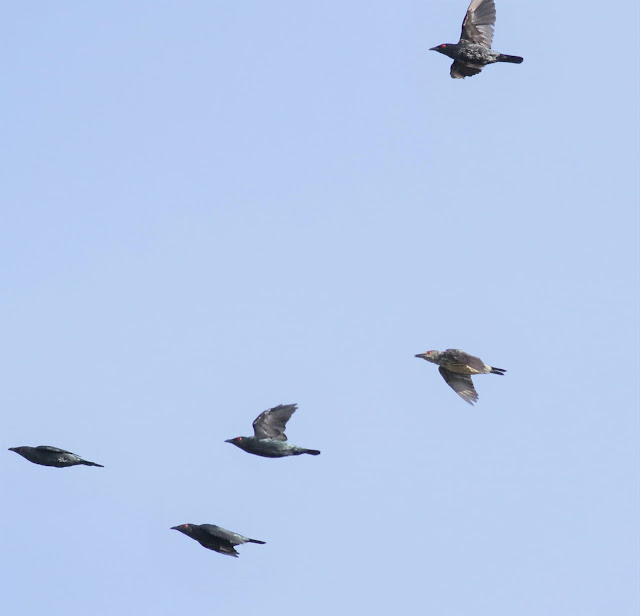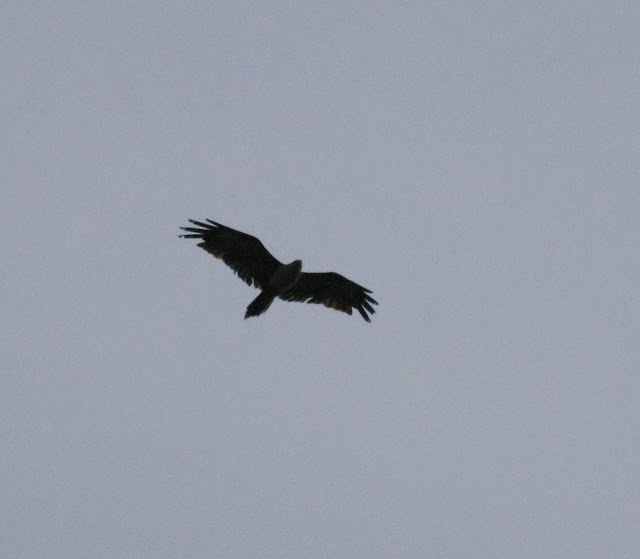When i was young i have always thought that the world will have seamless boundaries which one can never ever see but as i grow older i realised that the world is actually much smaller and getting smaller by the day. There were recent reports that Australia is slowly inching its way further north. This means that one day we will have cassowaries, kangaroos, koobaburras etc at our door steps. The unfortunate news is that this will only happen in about a million years from now. While waiting for that to happen, i have recently done a bit of bird watching near a town called Bedong in the northern state of Kedah. What was supposed to be a casual and relaxing event has actually turned out to be an interesting if not a significant trip. As the saying goes "Some of the Greatest Discoveries in Science Were Found by Accident"
The first day of a few trips to this area started as early as 6.45am on 12 September 2016! Heard a few calls from a nightjar which i believe it came from the most common nightjar in town which is the "Large-Tailed Nightjar" (Caprimulgus macrurus). From where i stood, i could also hear thunders roaring and lighting flashing from a distance.
This was the first significant find on the first day. An adult male Japanese Sparrow Hawk (Accipiter gularis). It was spotted gliding just over the tree top at 9.40am.
A local and an international raptor expert from Thailand was kind enough to confirmed its identification for me. (Note: its lack of a clear mesial streak). This sighting according to the expert is consistent with the early arrival of raptors in mid September (autumn migration). I was indeed delighted to be able to contribute some data to the local raptor records.
(Note: Despite its arched wings which is a typical flying posture of a raptor on cruising mode, it was however not as fast as the Peregrine Falcon. Despite that i was just able to take two decent shots of it)
Here it is again flying southwards. With its wings spread out wide, this raptor was gliding slowly to its winter ground which is reportedly to be at the neighboring country of Indonesia.
The second significant sighting was the arrival of the Oriental Honey Buzzard (OHB).
Here is another image of the OHB which was spotted just above the tree top as well.
Unlike the above A. gularis, this adult male orientalis OHB was cruising from east to west as can be seen from the above photo. This OHB was spotted on 15 Sept 2016 at 10.32am.
Here is another image of the OHB which was spotted just above the tree top as well.
I was curious to know why these two raptors were flying so low during their migration and i have only these hypotheses to describe the phenomenon:
This is a rather peculiar looking "Collocalia' species which face area is white. Saw a few of them with similar features.
i) Despite reports that thousands of migrant raptors have already appeared in Khao Dinsor at that time, i doubted the above birds of prey have flew in directly from that site. Weather conditions in the northern region at that time were not conducive enough for an early morning lift off. So the most likely reason was that the raptors have stayed at a nearby staging area overnight before it took off.
ii) The second reason could be that they may be looking for prey in the morning while waiting for the thermal to built up.
Aside from the above raptors, other common migrant birds were also spotted. All of them were flying southwards.
ii) The second reason could be that they may be looking for prey in the morning while waiting for the thermal to built up.
Aside from the above raptors, other common migrant birds were also spotted. All of them were flying southwards.
Looks more likely to be called a forked-tailed bee eater from this image but this bee-eater was a Chestnut-Headed Bee-Eater (Merops leschenaulti).
Despite these single photos seen here, they were actually travelling in a flock of 4 - 5 birds at a time.
Here is another bee-eater which is heading towards the same direction.
Blue-tailed Bee Eater (M. philippinus)
Some of them were also observed thermaling high up in the skies like some raptors.
From where i hide which was under a 'dokong' tree (bukan dugong lah !) which was facing an old durian tree, my views were only confined to 180 degrees. So when a flock of 7 - 8 Daurian Starlings (Sturnus sturninus) flew by, i have only enough time to take a photo of its two trailing members as depicted above. They are really fast flyers.
This is a "Barn Swallow". A very common winter visitor which is an early arrival too. Their numbers were just a handful as compared to the more common "Collocalia" species. In the field, you can identify 'Barn Swallows' from 'Collocalia' species in flight by looking at their wings. In flight 'Barn Swallow' wings are usually folded way back which makes them resemble an arrow head. To illustrate the arrow-like head profile in flight, here are some its photos taken in Nov 2016:
The above two photos were taken in KL.
An interesting wing profile of a "Collocalia". I think some air force could consider using this as one of their insignia. Their numbers have significantly increased but from my personal field observation, their numbers will peak in the coming months of January to February where you can observe them in thousands from this area. These swiflets fly out as early as 6.50am (personal field observation).
Here is another swiftlet with a peculiar looking bulging mouth area. I believe i have made some significant discovery to explain this bulging feature which i will share in my future posting soon.
Another peculiar looking swiflet of an unknown origin.
The local common birds were equaling stunning. Here are just some of them.
A squadron of herons flying southwards in a tight formation in the early hours of the morning. I believe they were "Black-Crowned Night Heron" (Nycticorax nycticorax).
The above photos actually depicted two different adult Brahminy Kites. I found it really hard to describe their differences except for some of its underwing features.
A flock of Asian Glossy Starlings flying in the opposite direction.
This "Common Iora" was looking at me one kind just like some passer by.
A splendid looking male "Olive-Backed Sunbird"
Have you seen a Pied Thriller (Lalage nigra striga) often before? Neither did i.
Quite a stunning species if you asked me.
Here is how it looks like from the back.
I believe this was just a common female "Pink-necked Green Pigeon".
The butterflies down here is equally stunning. This is a "Lemon Pansy" (Junonia lemonias) which are reportedly common only in the north-west of Peninsular Malaysia.
Nocturnal creatures are both mysterious and difficult to observe. That is why they are often understudied and intriguing. As dusk falls, out came these bats which i believe were just some common fruit bats.
Batman is calling you to Gotham City!
HAPPY BIRDING WHEREVER YOU ARE !


























































